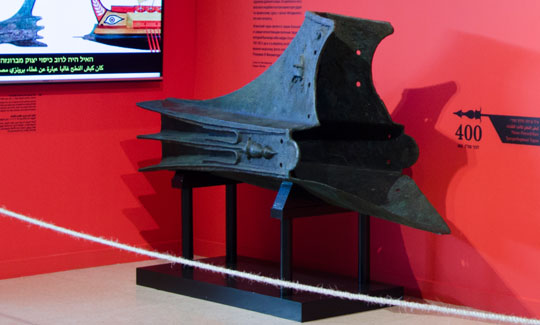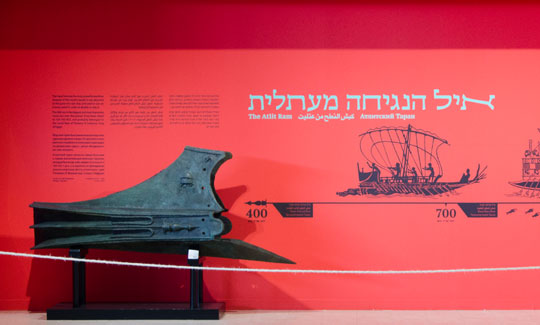One of the most important and rare discoveries of underwater archaeology in Israel is that of the Athlit ram. It was discovered by the late Yehoshua Ramon in 1980, in the northern bay of Athlit, and was retrieved from the sea by the staff and students of the Maritime Civilizations Department at the Centre for Marine Studies at Haifa University.
A ram is a weapon that was attached to the prow of a vessel at or below the water-line, and was intended to ram enemy vessels, inflicting damage that would prevent their further use, or even sink them.
The Athlit ram is one of the largest single bronze castings ever found. The bronze is of high quality, weighing 465 kg. Together with the wooden sections, when the ram was retrieved from the sea it weighed 600 kg. It was intended for tactical use, and was cast as a single unit. The first metallurgical analysis suggested that it was sand-cast in a hinged mould. A more recent opinion is that is was cast by the lost-wax process, in which a wax model is constructed and encased in clay. Molten bronze is then poured into the clay through specially constructed channels, melting the wax, which runs out through "risers" in the clay, and is replaced by the bronze.
The four symbols on the ram are integral to the casting. They are: Poseidon's trident, a helmet surmounted with a star - the sign of the Dioscuri, an eagle's head, and a caduceus - the wand of Hermes. They symbolize the deities who safeguard ships and protect seamen, and are also those of the ruling powers. They appear on coins minted in Cyprus between 204 and 164 BCE, allowing us to estimate that the ram was made in one of the Cypriot ports, and was intended for a vessel in the fleet of Ptolemy V Epiphanes, or of his successor Ptolemy VI Philometor. The carbon-14 test performed at the Weizmann Institute on sections of the ship's prow still adhering to the ram dated them to 400±130 BCE.
Examples of rams of varying sizes can be found at the Actium Monument commissioned by Octavian to commemorate his victory over Anthony and Cleopatra in the naval engagement at Actium (32-31 BCE). The supporting wall of the monument is lined with sockets for the rams of vessels captured in that battle. The Athlit ram is smaller, and was almost certainly attached to a Hellenistic vessel of medium size - a quadrireme, or a trireme with only three tiers of oars - an important vessel throughout the age of antiquity.
The three-pronged ram represents the last stage of ramming warfare in antiquity. This kind of attack seems to have originated in the use of the "nose" of the prow at the water-line. As of the 1st millennium BCE, there are representations of ships with single rams. In the 6th century BCE blunt rams were cast in the shape of a beast's head, and by the end of the 5th century BCE 3-pronged rams were being cast, effective for crushing the side of an enemy vessel and reducing the risk of the ship itself becoming embedded. Even after the advent of the 3-pronged ram, the single point and the blunt ram were still employed. As of the early 3rd century BCE, only the 3-pronged ram is seen, and in the 300 years that followed it was used in the great naval battles in the Mediterranean. There was a return to the blunt ram circa 100 CE. During the Byzantine era, with the use of more sophisticated weapons the ram disappeared, and the most recent evidence of ramming warfare is dated to the 6th century CE.


